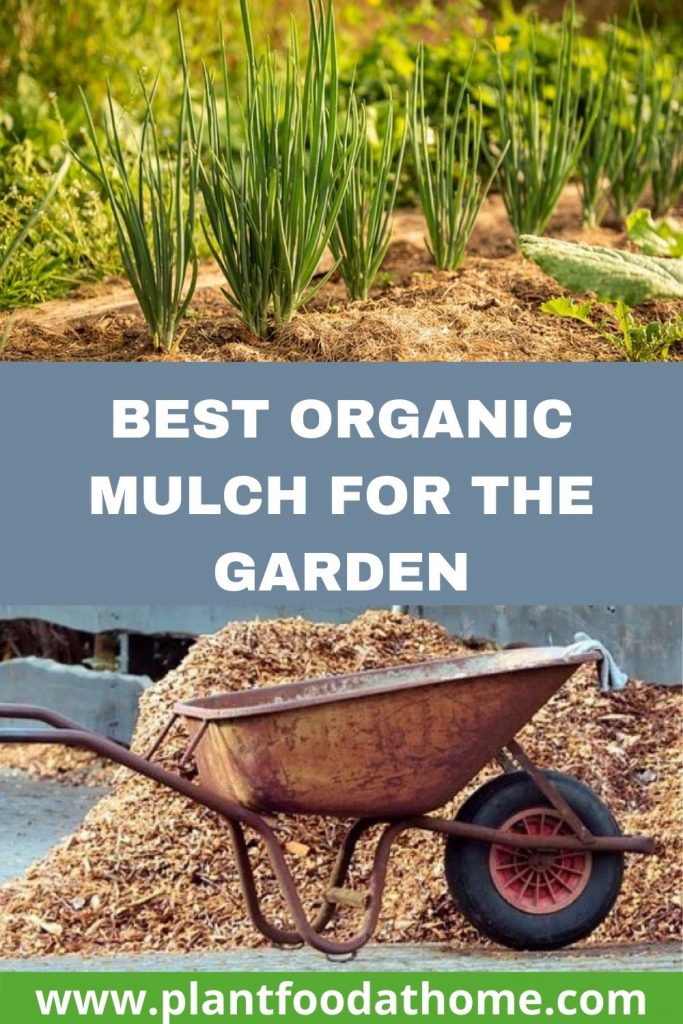Are you wondering whether or not you need to mulch your garden? Confused by all the choices of organic and natural mulches and wondering which is the right one for you? Well, you’ve come to the right place! Here we take a look at the best organic mulch for your garden.
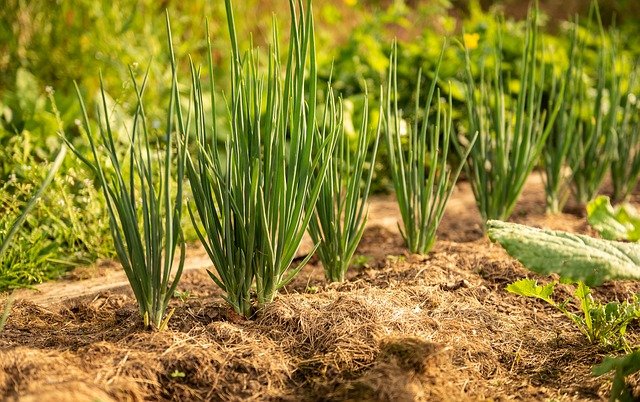
Table of Contents
- What is Organic Mulch:
- How to Use Organic Mulch:
- Spent Mushroom Compost
- Uncolored Wood Chips
- In all Wood Chip Cases
- Well Rotted Horse Manure
- Well Rotted Farmyard Manure
- Straw Mulch
- Chopped Corn Stalks
- Cotton Burrs
- Leaf Mould
- Seaweed Mulch
- Evergreen Boughs
- Living Mulch
- Cardboard and Newspaper
- Pine Needles
- Lawn Clippings
- Cracked or Ground Nutshells
- Seed Hull Mulches
- Conclusion
- Recommended Products
What is Organic Mulch:
Mulch is a thick layer of material that is placed over the soil and around plants. We use it to lock moisture into the soil and to create a physical barrier to drying winds and direct sun.
The condition of your soil is important, and organic mulches can work to improve the health of your soil.
Some mulches contain nutrients that benefit the plants and soil, making them a slow-release plant food. Worms take the mulch into the soil which improves soil structure, making it more moisture retentive and fertile and increasing free-draining properties.
Others are good to protect the ground and in some cases plants from cold, biting winds and frosty weather during the winter.
Some types of organic mulch suit summer protection that are great for their water retention properties.
Organic mulches comprise of dead plant material such as compost, leaves, bark or grass clippings. Just for the record inorganic mulches are made from stones or gravel, mined stone or rock or in some cases made from plastic.
Different mulches suit different jobs in the garden and requirements. However, most have a positive effect on the garden; some suit specific jobs better than others.
How to Use Organic Mulch:
- What part of the garden and what plants are you planning to mulch?
- What do you want to achieve from using the mulch?
Unless stated otherwise, all the mulches below have good water retention properties and allow water through to the soil.
Usually, spread organic mulch to a depth of between 2 and 3 inches. Spread an even layer, over the top layer of your soil. The versions that are heavier such as cedar chippings are well suited to use around the base of large shrubs and trees. Lighter textured, organic mulches are usually highly suited to use around bedding plants and flowers.
When mulching around trees, leave a 6 to 12-inch gap around the trunk. Ideally, mulch up to 6″ away with lower coverage of up to an inch, applying the normal level of mulch from about 12″ away.
Here’s the rundown of what we think are the best organic mulches for your garden:
Spent Mushroom Compost
Spent mushroom compost is the compost that has been used in the mushroom growing industry. It usually starts life as farmyard manure with straw compost and has lime added to aid the growth of the mushrooms.
The mulch is sticky and has the perfect mix of fibrous matter and water-retaining properties. The lime makes it sticky, it holds together very well on the surface of your soil to protect the soil below, and it won’t easily blow away.
X Because lime is added, the pH is raised to around 7 so that it is not suitable for azaleas, rhododendrons or any plants that don’t like a lime soil. Many ornamental plants prefer a lower pH.
✔ Spent Mushroom Compost is ideal for beans, corn, any leafy greens, brassicas, kale, cabbage and broccoli.
Uncolored Wood Chips
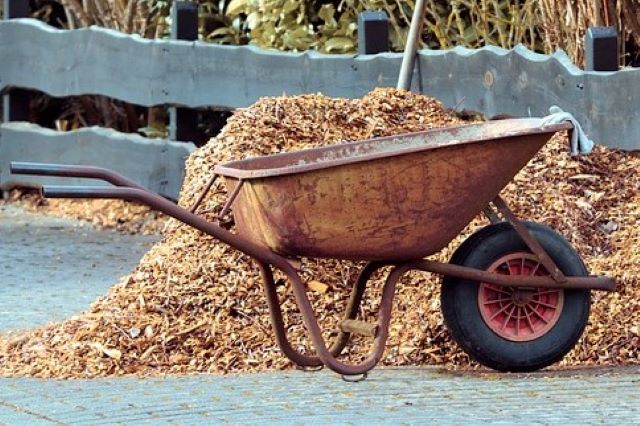
Wood chips are a good choice of mulch for areas that are not constantly being disturbed and replanted. They work around trees, but care should be taken to leave a mulch free area around the trunk. Natural, chemical-free, uncoloured wood chips are more environmentally friendly for your garden than colored varieties.
Wood chips are available in different sizes, shapes and types. Here’s the three you are most likely to use:
Pine Peelings (Pine Shavings)
Pine peelings a by-product of the wood milling processes. The peelings are a mixture of sizes and are usually lightweight. Buying them in sealed bags means you can check if they have been chemically treated. Buying in bulk from a sawmill direct you can ask for confirmation that they are from the raw timber and not prepared wood. When offered pine peelings cheaply, to do the best for your garden, make sure that they are not from treated wood as the chemicals could damage your soil.
A disadvantage is that they can get blown around or away or even float away following heavy rainfall.
Cedar Mulch
Cedar mulch is by far one of the best types of wood mulch you can buy. There are generally two types of cedar mulch; the heavier, denser chippings and the more delicate and lighter weight shredded cedar. In both cases the wood has natural oils that repel insects, making it a great choice of mulch in areas where termites are a problem.
Cedar mulch works for various reasons and is both functional and aesthetically pleasing.
Cedar works for soil insulation, weed inhibition, water retention, regulates soil temperature, as an insect repellent and is attractive.
Use the chippings in borders for weed suppression and shredded version works well around bedding plants.
A downside of cedar is that the chips may deter the useful insects along with those that you don’t want.
Tree Bark Mulch
Bark mulch is a popular choice that lasts well and retains water, inhibits weeds and insulates the soil. Large chips last longer, and they decompose much slower than small chips. What this means is that the large chunks have a negligible effect on nitrogen in the soil and need topping up less often than smaller sized bark chips.
You can make your own wood chip mulch from tree pruning’s at home with a wood chip mulcher such as this one on Amazon.
In all Wood Chip Cases
Your choice of wood chip should be a mixture of what you like the look of and exactly what your requirements are. When freshly put down, it looks fantastic and top up or replenish intervals depend on your individual circumstances. The wood chip mulches above are all excellent choices for water conservation because of the barrier they give against the evaporation of moisture.
✔ Wood chip mulch is best for mulching trees and shrubs, perennial flowers, orchards, and for the walkways in flower and vegetable gardens.
X Wood chips can be blown around in windy areas and can start to look messy after a time. Highly combustible when dry.
Well Rotted Horse Manure
Well-rotted horse manure retains moisture well and is packed with nutrients. The key with horse manure is the term “well-rotted” it should have been left to rot for at least two years and resemble compost with some visible straw matter.
✔ It’s a great choice for mulching around roses and hungry plants, especially pumpkins and squashes and other edible moisture-loving plants.
X A disadvantage is that if the manure is not well-rotted, it can ‘scorch’ plant leaves, hatch flies and even remove nutrients from the soil as it breaks down.
Well Rotted Farmyard Manure
A natural mulching alternative to horse manure.
✔ A good, nutrient-rich choice for flower beds. Use the suggestions above for horse manure when horse manure is not available.
X Like horse manure, it is essential for maximum efficiency that the manure is well-rotted, and this is especially the case with chicken manure that can easily ‘scorch’.
Straw Mulch
Straw can be a good choice of mulch for the vegetable garden. It needs to be a minimum of 6″ deep to be most effective when it will suppress weeds, retain water and help keep vegetables and fruits like strawberries clean. The straw will also offer a little warmth protection and makes a good cover over for autumn-sown vegetables. Straw composts well and will be breaking down and adding nutrients to the soil when used as an organic mulch. It can be dug in where it is, or better still added to the compost pile.
✔ Good for winter protection of autumn-sown vegetables and flowers. Good for keeping fruit and vegetables clean in the summer.
X The downside of straw is that it will blow around and make the plot untidy during dry spells.
Chopped Corn Stalks
Chopped corn stalks and ground cobs help with water retention, weed suppressant and soil temperature moderation. At the end of the season, the mulch can be added to the compost or turned into the soil.
✔ Fire resistant, a good choice for around trees and shrubs over winter.
X Don’t be tempted to use un-ground corn husks though as they are more likely to attract vermin. The husks are light colored and not as attractive as some other choices.
Cotton Burrs
Good for water retention, suppressing weeds and help moderate the soil temperature. Cotton works well for vegetable gardens, but you want cotton from an organically sourced grower, or that has minimal pesticide treatment. Cotton burrs comprise of the seeds, leaves, hulls and stems from cotton plants. It is coarser than some other garden products.
The best way to use cotton burrs is to spread it evenly around the plants to a thickness of about an inch and then cover with heavy mulch such as woodchips to stop it blowing around.
✔ Cotton Burrs works nicely to improve the soil by adding tilth, and to break down heavy clay, which is useful for improving water retention. Nutritionally it is around10% nitrogen and 10% potassium with no phosphorus and will act as a gradual feed as it roots down.
X Requires a second mulch on top for optimization.
Leaf Mould
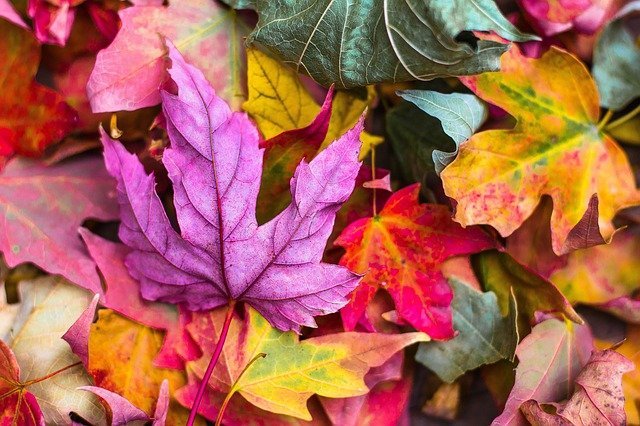
An excellent soil conditioner that is low in nutrients. Easy and free if you have leaves to clear. Put them in bags and leave for 12 months, then spread around plants as a mulch the following autumn to add some protection to the soil and water retention.
X Store for a year before use. Plants may still require fertilizing.
✔ They add organic matter, retain water and can be turned into the soil in the spring. Leaf mulch works well in vegetable and flower gardens.
Seaweed Mulch
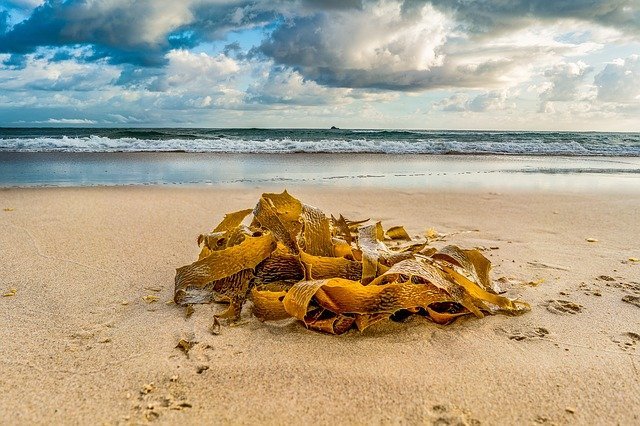
Seaweed retains water, suppresses weeds, seaweed shares no diseases with land plants and will not have weed seeds with it. As the seaweed breaks down, which it does quite quickly, it improves the soil.
Because seaweed has a natural salt content, it repels slugs and snails naturally. Within a few days of being put around the plants, it dries becoming crispy; creating a perfect slug and snail repellent of salt and crisp sharper edges.
Seaweed is a broad spectrum fertilizer; it contains ready to use micro-nutrients, is rich in beneficial trace minerals and hormones that stimulate plant growth. Seaweed is also high in carbohydrates, essential building blocks in growing plants. Adding seaweed mulch to plants that are not performing for no apparent reason, will often give them the boost they need. A great choice for the vegetable garden.
X Disadvantages of seaweed mulch may be the seaweed smell, but it diminishes as the seaweed dries.
✔ Helps to lighten compacted soil, great for repelling slugs and snails and boosting plants. Think of it as the ultimate organic mulching for soil improvement.
Think of it as a power boost feed mulch, if you want wind and sun protection, you’ll have to replenish frequently or follow on with another mulch.
Evergreen Boughs
Retaining the boughs of evergreen trees and large shrubs when the tree or shrub is trimmed is useful to cover less hardy shrubs and perennials to help protect them in the winter. They should give good insulation if you have enough to layer them.
Good for water retention, moderating soil temperature and can assist with weed suppression.
✔ Handy if you already have them and need to offer protection to plants.
X Not as good at weed suppression as most of the others and cannot be turned into the soil, so may need removing after a few months.
Living Mulch
These are ground cover plants that will suppress weeds, retain water, moderate the soil temperature, add organic matter and look nice.
✔ By choosing ground cover plants that you like, they are a pretty addition to your flower garden or specimen shrubs.
X The disadvantages of these as a mulch is that they can spread too much and may require, cutting back and pruning.
Cardboard and Newspaper
Ideal for anywhere that you want to suppress weeds, especially if you don’t mind what it looks like. Cardboard works well and can be one or two layers thickness. Newspaper should be a few sheets thick and covered with another mulch material or some small rocks to hold it in place. Paper will deteriorate quickly in wet weather, so is a short term solution to clear weeds.
X No aesthetic advantage. Paper will break down; not for constant use as printing ink may contain harmful chemicals.
✔ These are good options when creating new flower or vegetable beds and want to suppress the weeds before starting.
Pine Needles
These work well for orchards, ornamental and vegetable gardens. They are good for water retention, moderate temperature and have a slight impact on weed reduction.
✔ Pine needles easily let in water. When applied thickly, pine needles help with frost protection.
X Disadvantages are that pine needle mulch cannot be turned into the soil; it needs removing and replacing at the end of the season. When the weather is dry, the needles can blow away, and they can look untidy.
Lawn Clippings
Lawn clippings work best on the lawn. Using a thin layer of lawn clippings of about an inch can help with water retention and lawn fertilization. The best way to use lawn clippings as a mulch on your lawn is by using a mulching mower.
Lawn clippings can be used sparingly on vegetable gardens, but are best added the compost pile and used once they have rotted down.
✔ If you have a lawn, they do add organic matter and retain water. They are a natural occurring (free) mulch in your garden.
X Disadvantages are that when not used with a mulching mower, they can look messy and blow about when dry. They also occasionally create clumps that mat up, preventing light from getting through to the grass below and sometimes they turn to green slime.
Cracked or Ground Nutshells
Ideally suited as a light mulch for ornamental gardens. They help with water retention, suppress weeds and moderate soil temperatures.
✔ Decomposing rate varies, but they are all relatively slow and look attractive for a long time.
X They can blow around in the wind and end up in little clumps that need raking. They are unsuited to sloping ground.
Seed Hull Mulches
Buckwheat, cocoa beans, cotton and rice
These help retain water, suppress weeds, moderate soil temperature, add organic matter and can be turned into the soil at the end of the season. Best suited to vegetable gardens.
Because they are lightweight, they can blow around in the wind. Check cotton mulch has not had a lot of pesticides applied. Cocoa mulch can go moldy when used in humid and damp situations. Cocoa can sometimes form a mat and prevent water getting through.
✔ Because cocoa can have high levels of potassium; it’s a good choice for using around fruit bushes, especially strawberries as well as fruiting vegetables such as tomatoes and squashes.
X However, care is needed when fertilizing an area that has been cocoa mulched. Choose a fertilizer that is lower potassium, so you don’t add too much potassium, which could lead to algae growth in water runoff areas.
Seed hull mulches require replenishment each year.
Conclusion
So, there you have a rundown of the best organic mulch for the garden
Deciding what you want to obtain from the mulch is your first step to choosing a mulch for your individual needs. As you can see, we often end up buying different mulch for different areas when working with organic mulch types. Here, we have given you the information that will help you make the right choices for your garden.
Recommended Products
Further Reading:
- Why Does Mulch Smell Bad? (And How to Fix It)
- Uncovering the Truth: Are Coffee Grounds Good for Plants?
- Natural and Organic Vegetable Garden Weed Control Methods
- Milk Spray For Powdery Mildew (Natural Fungicide for Plants)
- Natural Remedies To Remove Stink Bugs From Citrus Trees
- Planning a Square Foot Garden for Abundant Vegetables
- Why Is My Raised Bed Growing Mushrooms? What You Need To Know
- 30 Surprising Things You Can Compost At Home
- 26 Winter Vegetables To Grow in Your Garden
